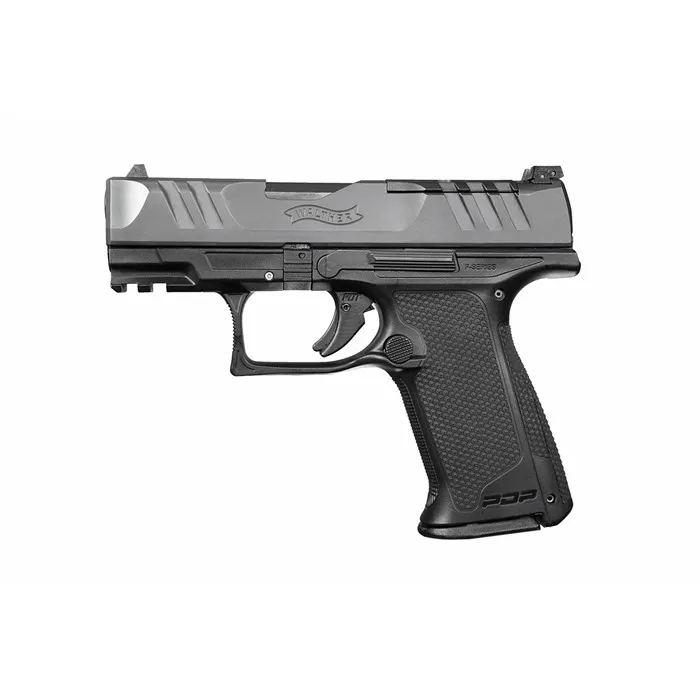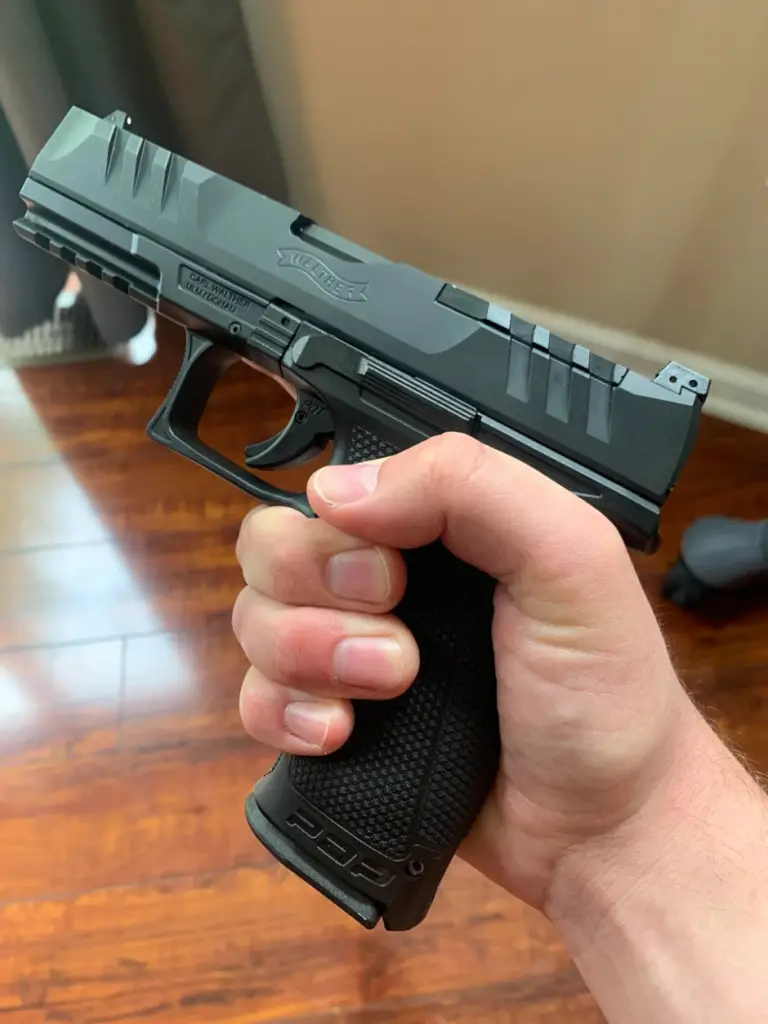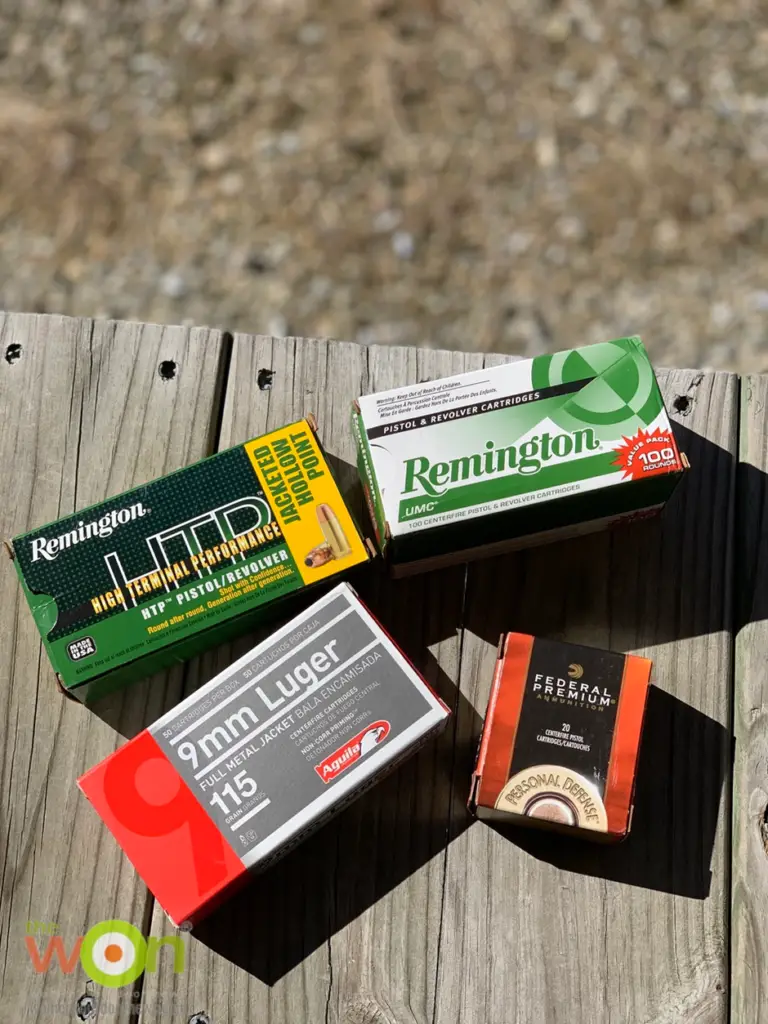Mention Walther and most people immediately flash back to James Bond, a beautiful girl, and the iconic Walther PPK that became synonymous with the Bond Franchise.
However, Walther has not stood still to bask in the fame brought to its handguns by the movies. In 2021, Walther introduced the PDP (Performance Duty Pistol) to the world to replace the PPQ models then under production.
The Walther PDP is a striker-fired, recoil-operated, semi-automatic pistol that fires a 9mmx19 cartridge. There are several variants in the PDP line, including a PDP compact variation. The new PDP features a longer and improved grip texture. The latest variation, the PDP Pro, comes from the factory with a threaded barrel, an optic cut on the slide, and an improved trigger.
The PDP is a distant relative of the PPK. The two guns don’t share much but the name. However, Walther has raised the bar with the introduction of the PDP and stepped into the striker-fired pistol arena ready to take care of business. A look at the details that set the PDP apart may well convince you that your gun safe has a place to be filled with a Walther PDP.
SKIP AHEAD
The Walther PDP and the Walther PPQ
Many people wonder if the Walther PDP is simply an upgraded version of the Walther PPQ. This is, I suppose, an easy assumption to make for some shooters. It isn’t unusual for a gun manufacturer to add a few new features, change the styling, and put on a new model designation. Not so in this case.
The Walther PDP is a completely new design from the Walther. In my opinion, the Walther PPQ in its last version was an extremely efficient and effective firearm. It shot well and its striker-fired trigger was a welcome relief from some of the other gun manufacturer’s designs.
However, the Walther PPQ does have some shortcomings that the Walther PDP addresses. It is evident after some examination that the Walther PDP was designed for an American market. The Walther PPQ was originally designed for law enforcement and military use by European countries. This pistol never did catch on well in the U.S. because of some of the European-style features. The Walther PDP addressed these differences quite successfully.
 |
|
Check Price on Brownells.com |
The Technical Details of the Walther PDP
No pistol review would be complete without an understanding of the technical specifications of the pistol being reviewed. Let’s get the technical details out of the way before we get into the meat of my Walther PDP review.
Walther PDP Factory Specifications PDP Compact Version
- Overall Length – 7.5 inches
- Slide Length – 7 inches
- Width – 1.75 inches
- Height – 5.4 inches
- Barrel Length – 4.0 inches
- Sight Radius – 6.4 inches
- Optic Ready – Yes
- Trigger Reach – 2.76 inches
- Weight without magazine – 21.4 ounces
- Magazine Capacity – 15
- Trigger – Performance duty trigger
- Trigger Pull – 5.6 pounds
- Trigger travel – 0.28 inches
- Slide Material – Steel
- Frame Material – Polymer
The PDP Compact model is also available with a 5.0-inch barrel. The PDP Compact is meant to be a concealed carry firearm and among the Walther PDP models, it is one of the most popular with buyers.
Walther PDP Full Size Factory Specifications
- Overall Length – 7.5 inches
- Slide Length – 7 inches
- Width – 1.75 inches
- Height – 5.7 inches
- Barrel Length – 4 inches
- Sight Radius – 6.4 inches
- Optic Ready – Yes
- Trigger Reach – 2.76 inches
- Weight without magazine – 21.5 ounces
- Magazine Capacity – 18 rounds
- Trigger – Performance duty trigger
- Trigger Pull – 5.6 pounds
- Trigger Travel – 0.28 inches
- Slide Material – Steel
- Frame Material – Polymer
The PDP Compact model is also available with a 5.0-inch barrel. The PDP Compact is meant to be a concealed carry firearm and among the Walther PDP models, it is one of the most popular with buyers.
Walther PDP Full Size Factory Specifications
- Overall Length – 7.5 inches
- Slide Length – 7 inches
- Width – 1.75 inches
- Height – 5.7 inches
- Barrel Length – 4 inches
- Sight Radius – 6.4 inches
- Optic Ready – Yes
- Trigger Reach – 2.76 inches
- Weight without magazine – 21.5 ounces
- Magazine Capacity – 18 rounds
- Trigger – Performance duty trigger
- Trigger Pull – 5.6 pounds
- Trigger Travel – 0.28 inches
- Slide Material – Steel
- Frame Material – Polymer
The slightly longer grip allows better hand placement on the PDP Full Size. However, even with the longer grip, the compact model is easy to concealed carry. Walther also offers this model with a 4.5-inch barrel and a 5-inch barrel.
Walther PDP SD Pro 4 Inch Specifications
- Overall Length – 8.1 inches
- Slide Length – 7 inches
- Width – 1.75 inches
- Height – 5.9 inches
- Barrel Length – 4.6 inches
- Sight Radius – 6.4 inches
- Optic Ready – Yes
- Trigger Reach – 2.8 inches
- Weight without magazine – 22.8 ounces
- Magazine Capacity – 17
- Trigger – Dynamic Performance Trigger
- Trigger Pull – 5.6 pounds
- Trigger Travel – 0.2 inches
- Slide Material – Steel
- Frame Material – Polymer
The addition of a threaded barrel adds to the length of the Walther’s PDP Pro models. You can get this model with a 4.5 inches threaded barrel as well. The PRO SD model is not as concealable as the other models, but who is going to concealed carry a suppressed pistol?
Into the Workings of the Walther PDP
With the technical details out of the way, let’s get this Walther PDP review started with a look at the way the PDP works, shoots, and handles. There are certain areas that always figure into any gun purchase I am contemplating. These are the things that I consider critical for any gun I may choose as a personal defense firearm.
Your critical factors may be different, especially if you don’t routinely carry concealed and only use your pistols for competitive or target shooting at the range. Bear with me, and I will try to speak to some of these factors as well.
The Look and Feel Of the Walther PDP
My first impression when I open the case holding the Walther PDP for the first time is a good one. The gun comes packed into a hard case with foam interior and cutouts for all the included parts. Each Walther PDP comes with the pistol, of course, two replaceable back straps, a cleaning brush, two mags, a speed loader, and the user manuals.
In general, the Walther PDP feels good in your hand. The grip rake seems to be perfect for most people’s hands and wrists. One thing I found a bit disconcerting was the small hump on the lower grip at the back. When I looked at the Walther PDP, it occurred to me that this might make the grip uncomfortable on long strings of shots.
Fortunately, this did not prove to be the case. The grip, once I adjusted to it, conformed to my hand well. A few rounds downrange proved that Walther may know something about designing pistol grips that I didn’t know. The PDP frame is solid and performs well.
The fit and finish of the Walther PDP are without reproach. Walther has a reputation for manufacturing excellence, and its German engineering heritage is apparent. From the packaging to the slightly rounded edges of all the corners, the Walther PDP gets high marks.
The Grips
While we are looking at the Walther PDP, the grips deserve some additional inspections. Beyond the slightly strange curvature of the backstrap, which does work after you adjust to it, the grips are comfortable and ergonomic. The performance grip texture works as a non-slip grip even when your hands get sweaty on a hot afternoon on the range.
The interchangeable backstraps allow you to customize the size of the grip to suit your hands. The change in backstraps is relatively easy and can be performed without disassembling the pistol. Subtle finger grooves on the grip fit naturally into your hand.
The stippling on the Walther PDP is a little different than what most Americans would expect. The texturing on the grips is much more pronounced and covers almost all of the grip surface. The feeling is solid and secure, which boosts confidence.
The Controls
When you purchase a pistol that defines itself as a duty pistol, you naturally expect the critical controls of the pistol to be readily and easily manipulated. Walther’s earlier pistol models were crafted for a European audience. Many Americans found the controls to be different enough to cause some concern. The Walther PDP addresses these concerns successfully.
The magazine release button is improved. The texturing on the mag release button is much improved over the earlier models and provides a better feel. The mag release button is located in a standard position that falls near the thumb of the shooter’s strong side hand.
The slide stop lever is also well-positioned and well-designed. The lever doesn’t stick out too much so it interferes with a proper gun grip. The lever is long enough to give make operating the slide stop lever easy without undue strain.
There is no manual safety on the Walther PDP. The safety mechanisms are all built into the trigger system. More about the trigger will be discussed later in the article.
Sights and Optics
The Walther PDP comes optics ready as a standard feature. Walther installs the cover plate on the optics cut out to retain the standard look. When you remove the cover plate from the slide cut out, you find the slide is pre-drilled to accept plates for almost all optic choices. As an older shooter, I can tell you that the addition of an optic to your pistol can make a world of difference.
If you prefer iron sights, Walther has gone a step above with the sights on the PDP. The PDP features adjustable sights on the rear sights that can be easily manipulated for windage. The sights feature a three-dot configuration, much like Glock sights. The sights on the Walther PDP are functional, but my recommendation is to add a red dot to your pistol for enhanced accuracy.
The rear sight is adjustable for windage but requires a tool that Walther does supply with the gun. I would much prefer a rear sight that can be adjusted for windage without having to keep up with a tool. However, the sights are functional.
One shortcoming that I noticed with the PDP Pro models is the lack of an option for higher iron sights if a suppressor is installed on the pistol. Walther could offer an option for suppressor height sights for those who wish to use a suppressor with the installed sights. One downside is the optics plates are sold separately.
The Trigger
The quick defense trigger system on the PDP is aptly named. The performance duty trigger delivers precise and controlled trigger pull and break. This is different from most striker-fired pistols that require the trigger action to also load the striker spring. Like the PPQ, the only action the trigger pull performs is to release the trigger safety and engage the sear. The striker spring is preloaded by the recoil action.
Walther has also shortened the trigger take-up and lightened the trigger pull when measured against the PPQ. Good job Walther for a superior design.
Disassembly and Maintenance
Anyone familiar with the take-down procedure for a modern striker-fired gun will instantly recognize how to break down the Walther PDP for cleaning. After making sure the gun is safe by removing the magazine and checking the chamber, pull down on the takedown crossbar and press the trigger to release the slide. Move the slide forward off the frame to expose the recoil spring and guide rod assembly.
Walther recommends that you follow a standard maintenance routine with your PDP handgun. Regular cleaning of the operating parts, a touch of lube where metal meets metal and a swab down the barrel are usually all that is required. Reassembly is the reverse of the take-down. Once the slide is back in place, check the slide release to ensure it is fully back in the locked position and cycle the slide a few times.
The Magazines
Walther packages the PDP with two metal magazines. If you purchase the compact model, the magazines will hold 15 rounds. The full-size model magazines hold 17 rounds. I should mention here that the 17-round magazines will fit in the compact version and operate perfectly. In fact, Walther sells a small adapter that slips on the 17-round magazine and fills the gap between the bottom of the longer mag and the bottom of the grip.
Other than that, the magazines are standard issue and extras can be purchased for a pretty reasonable price. Manufacturers’ magazines fit flush with the magazine well and have a rounded polymer bottom. This helps reduce the snag points that you find with some magazine designs.
The Slide
If there is one thing that identifies a Walther before anything else when you look at it, it is the blocky nature of the slide. It seems to me that German engineers prefer nice straight lines. The slide is made of steel and has a nice solid feel. Walther’s quality is evident in the slide finish.
Operating the slide is easy and secure. This pistol boasts enhanced slide serrations that are aggressive and make for a secure grip when operating the slide. The deep slide serrations make for improved slide manipulation during the loading or clearing operations. It is obvious that this is a gun designed to be used on the range as well as a duty handgun for professionals.
The relief cut is factory milled for mounting an optic is deep enough to handle some of the largest holographic and reflex sights on the market. If your optic is a bit larger than many, you should have no trouble with this mounting system.
The empty chamber indicator is easy to see and provides unmatched reliability. All in all, the slide on the Walther PDP is well designed and engineered.
The Barrel
There are several variants of the Walther PDP, each with a different barrel length. The compact models feature a 4-inch barrel. The PDP full-size models can be found with a 4.5 or 5 -inch barrel length. If you choose the PDP Pro models, you can get this variation with a 4 or 4.5 inches threaded barrel length.
The barrels are constructed of stainless steel and feature a 250 mm twist rate, which is standard for almost all 9mmx19 pistols. This translates to about a 1:10 twist rate for those of you who are metrically challenged.
On the Range with the Walther PDP
We shot the Walther PDP full-size handgun for our range tests. We used a loaner gun from a friend’s indoor range inventory, so it is almost impossible to know how many rounds have been fired through our test gun. However, as you will find out, the gun seemed in perfect working order.
My test consisted of firing 300 rounds in one afternoon. I typically fire one or two magazines to get a feel for the pistol so the actual round count is slightly more than 300 rounds. I don’t report on the practice rounds as part of my testing.
I fired 250 rounds of ball ammunition at various ranges. Some magazines were loaded with a practice round to force a simulated mag change or stoppage in the gun. All in all, I tested this gun at ranges of 25 yards, 15 yards and seven yards.
The Results
The Walther PDP full-size handgun performed flawlessly through the first 250 rounds. Other than my forced stoppages to test reloading, I didn’t experience a single failure to feed or stove pipe. Shooting the last few rounds of the ball ammunition I intentionally limp-wristed the pistol to try and force a failure to feed. Without going to unsafe extremes, I could not get the gun to fail to feed.
Ball Ammunition
At 25 yards, the Walthers pedigree is apparent. The gun has easy recoil recovery and the return to target was quick and accurate. During my forced reloads, the magazine release was easy to find and manipulate. The supplied magazines dropped free cleanly when the magazine release was pressed. Accuracy was more than acceptable. I was able to keep all my shots at 25 yards in the 8 ring on a standard silhouette target.
At 15 and seven yards, things improved considerably. Again, all but one flyer found its way into the 8-ring with the majority being inside the 9-ring. I attribute the one flyer to fatigue as it was near the end of the 250-round string of shots.
Self Defense Ammunition
The real test of any handgun that you intended to conceal is its capability of feeding and shooting specialized self-defense ammunition. Ball ammo is fine for range practice and plinking. In a self-defense situation, I want the best and most aggressive ammunition I can find in my gun. Unfortunately, some striker-fired pistols don’t feed this type of ammunition as reliably as you might expect.
The last 100 rounds of my test were made with a variety of the most popular self-defense rounds on the market. The Walther PDP handled all of these cartridges without a problem. My last mag was filled with a random mix of the different self-defense cartridges. Again, the Walther chewed through them without a hitch.
Recoil
The recoil of this gun is easily controlled, and there is very little tendency for muzzle flip. This aids in a high level and better control than with some other guns.
Accuracy
As far as accuracy goes, I could not find a single thing to complain about. It is my overall opinion that the Walther PDP, in the hands of a better marksman than me, is up to the task. I found the gun fun and comfortable to shoot and produced decent groups. I wished that I could have mounted a red dot sight during the test, but since this was a loaner pistol, I abstained.
The Interpreted Results
I am the first to admit that my range testing is not all that clinical or scientifically based. I do not chronograph any ammunition and all the shooting is done using my standard stance and grip. There are no rests or vices used. What I found was the Walther quality translates to the range as well as it does under scrutiny on the bench.
Any firearm is only as good as the operator. I am convinced that the Walther PDP will shoot much better and with more accuracy than I can. This firearm has one of the best triggers I have found on a striker-fired handgun. Overall, this was a great performance on the range.
The Pros and Cons of the Walther PDP Review
To be honest, I don’t have too much to say in the negative vein about these handguns. Overall, I think these guns are an excellent value and should be on the shortlist for anyone considering purchasing any new firearms. As you might expect, the list of things I like is far longer than the things I don’t like about these firearms.
The Pros
Optics Ready Slide
Walther has done a good job of making this line of firearms optics ready and friendly. Mounting red dot sights is an almost painless task using the mount plates.
The Trigger
The excellent trigger makes the Walther PDP a dream in my book. The trigger break is crisp and clean. The take-up is amazingly short allowing rapid follow-up. There is no creep or sloppiness in the action.
The Grip
The grip textures are unlike anything I have seen. The Walther design, even though it looks a little odd, works well and is comfortable in the hand. Some aggressive stippling tends to be abrasive, but the Walther offers a positive grip without discomfort.
Reliability and Performance
The Walther PDP that I used for my testing never hesitated with any of the ammunition I provided. These guns seem to have no problem with ball or self-defense rounds.
Look and Feel
How guns feel in my hand is a big part of my gut response to my likes or dislikes. A gun that is uncomfortable or feels wrong doesn’t shoot as well for me. The Walther PDP seems like a natural fit in my hand and feels great when I shoot. The contouring on the grip fits very well with my hand. These firearms just feel good when shooting them.
The Cons
Optics Ready with Caveats
While Walther advertises that the PDP is optic-ready, you must purchase the mounting plates separately for your chosen optics. This is an added expense that could have been avoided had Walther simply included the three or four most common mounting plates with the firearms. This is not the best choice by Walther from a marketing view.
My Final Thoughts and Recommendations
In my mind, you aren’t ever going to go wrong choosing a Walther firearm. In the case of the PDP, I recommend this pistol for both new and experienced shooters alike. This is an awesome handgun that anyone should be proud to own. If you are in the market for a polymer pistol, consider the Walther PDP. It is overall a great gun and a good deal.
Out of the box, this is a gun ready to go to the range and start shooting. This gun meets all of the requirements that I look for in a pistol that I intend to carry. This is a great gun for home defense, personal carry, or competitive target shooting.






















